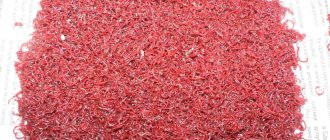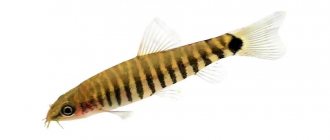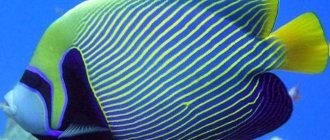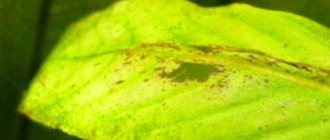The animal Cyclops is a crustacean belonging to the copepod family. It belongs to crustaceans, but its body structure greatly distinguishes it from other representatives of this class. The cyclops serves as food for most species of fish and can itself eat fry. It can be found in almost every fresh body of water. Thanks to the vital activity of these creatures, the water becomes cleaner, brighter and of better quality than that in which they do not live.
Cyclops is a crustacean from the copepod family.
Description of the species
Often all crustaceans of this family are called cyclops, although this is incorrect. Each individual species has its own unique structure. The largest cyclops reach 4.5 mm in length; although exceptions do occur, they are very rare. Typically, the growth of crustaceans is from 0.5 to 2 mm. They are divided into females and males, whose sexual characteristics are well expressed and noticeable upon closer examination. Their color may vary depending on the food eaten, although the most common colors are:
- grey;
- red;
- green.
Cyclops are predatory microorganisms
Despite their tiny size, cyclops are predators . They make a sudden dash to catch an unsuspecting victim by surprise. If for some reason it was not possible to catch anyone, then the crustaceans feed on algae. Since they themselves are food for the inhabitants of fresh water bodies, it happens that through them fish and humans are infected with parasites (through the consumption of infected fish).
Most often, crustaceans live in the coastal waters of lakes and rivers. Sometimes they can be found in puddles of melted snow.
Buying in a store: how much do they cost?
The easiest way is to buy frozen crustaceans. The price per kilogram ranges from 200 to 600 rubles. Live cyclops will cost more, the price depends on the supplier. They are usually not sold in stores. Occasionally, crustaceans can be found in online stores. They are most often found in pet markets. Some owners also grow food for sale.
Dried cyclops should not be used.
Cyclops are healthy and nutritious food. The fish that eat them are healthy and brightly colored. If desired, crustaceans can be caught independently at any time of the year.
Do you feed your pets Cyclops? Maybe you grow them yourself? Let us know which ones suit your fish best!
Body structure
The structure of the Cyclops is very different from the anatomical structure of its relatives. He has a very complex head, on which are located:
- eyes;
- legs-jaws;
- oral apparatus;
- two pairs of antennas.
One pair of antennas is longer and much better developed than the second. It is with the help of this more developed pair that the crustacean achieves great speed. It is able to push off not only from water, but also from the bottom, algae or other objects.
Cyclops has one pair of antennae more developed than the other.
Despite its small size, Cyclops is capable of moving over long distances - an adult can cover 75 mm in one second. It is 25 times faster than a submarine traveling at average speed. In addition, this pair of antennae performs additional functions, for example, supporting food and can hold the female during mating.
The entire body of this crustacean is divided into segments . There are five of them in the thoracic region, and 4 in the abdominal region; at the end, the abdomen is divided into two parts. The legs, thanks to which the Cyclops makes swimming movements, are located on the chest and are covered with bristles. The remaining 4 pairs of legs perform auxiliary functions.
The crustacean has no heart; its organs are washed by colorless hemolymph. The circulation of this substance occurs due to the pulsation of the intestines.
The nervous system is represented by a kind of brain located in the head. The crustacean's nervous system has no nodes. There are no lungs, but he breathes with his whole body. In addition, he sees well, although he has only one eye.
Classification of Cyclops
Not everything is clear with the classification of Cyclops. So, according to Wikipedia it looks like this:
- Type: Arthropods
- Subtype: Crustaceans
- Class: Jawfish
- Subclass: Copepods
- Squad: Cyclops
- Family: Cyclops
That is, here, shaking the foundations of my worldview, crustaceans are not a class, but a subtype. Copepods are classified as a subclass of Cenopods . In general, perhaps it is more correct and more modern, but for simple amateurs who do not go into the taxonomic jungle, it is easier to rely on the old classification (TSB), so at least there is a chance to remember:
- Phylum: Arthropoda (Arthropoda)
- Class: Crustaceans (Crustacea)
- Order: Copepoda (Copepoda)
- Family: Cyclops (Cyclopidae)
- Genus: Cyclops
- Species: Cyclops coronatus
Reproduction and larvae
To determine the sex of a cyclops crustacean, just look at it under a magnifying glass: females have a small pouch at the end of their body. These crustaceans reproduce at a high speed, which helps maintain the population and survive even in small vessels and aquariums. They are able to colonize the body of water they find themselves in in a short period of time.
Cyclops larvae, called nauplii, are born in the very sacs at the end of the female’s body that allow the sex of the individual to be determined. There can be a different number of egg sacs - from one to three. The larvae fully grow in them, but differ quite significantly from the adult. After bearing the offspring (usually 10 to 12 eggs), the female sheds the bags because they have stretched. Later she grows new ones.
Cyclops larvae, called nauplii
In natural conditions, it is quite difficult for fish to catch both larvae and adults, because they are very mobile. For this reason, aquarium fish should be given a very small amount of crustaceans, otherwise the uncaught ones will multiply, fill the aquarium and eat the fry themselves.
Who are the Cyclops?
Well, firstly , this is a popular fish food, along with daphnia and gammarus, but this aspect of their life (or rather, death) is of little interest, so we will not dwell on it.
Cyclops (Cyclops coronatus) in reflected light
Secondly , these are small (0.6-6 mm) crustaceans belonging to the order copepods.
Interesting Facts
You can use crustaceans as food for aquarium fish, both frozen and live. They contain all the necessary nutritional elements. It should be noted that the class of Cyclops crustaceans includes several species. One of them, Calanus, can even live in salt water and is a major part of plankton.
The body of Cyclops is able to adapt to any climate change. They are able to survive even when completely frozen in ice: this happens due to the fact that under unfavorable conditions, crustaceans secrete a special substance with which they envelop their body. In this case, the individual becomes like a cocoon, inside which all the processes necessary to maintain life occur. The same mechanism allows you to survive if the reservoir dries up. These creatures can maintain their cocoon for several years, but most often this is not necessary.
Cyclops adapt to any temperature conditions
Another amazing property of cyclops is the ability to survive in an environment unfavorable for other organisms. For example, one of the species, Cyclops strenuus, is able to exist for some time in water with hydrogen sulfide.
Many other species are resistant to acids, alkalis, gases and other substances that are harmful to others.
There are not only crustaceans, but also cyclops insects. True, they are completely unrelated. Cyclops are the name given to moths and nigella butterflies. This name is associated with the color of their wings - they have spots similar to eyes.
Cyclops as fish food
Cyclops are at the bottom of the food chain. They serve as food for many freshwater fish. Crayfish are nutritious and contain all the necessary substances. Nauplii are good for feeding fry.
Interesting fact: fish that eat cyclops have brighter colors. This is especially true for red fish.
Live food
Live cyclops are bred, purchased, or caught from streams. It is always best to feed live fish food. Breeding and catching are associated with certain difficulties. It is difficult to catch agile crustaceans. You will have to store it in a dark, cool place in a wide container. 3-5 centimeters of water is poured there.
For home breeding, a separate aquarium is required.
Note! Feeding a live cyclops must be done very carefully. Do not give too large portions. Uneaten crustaceans will multiply and fill the aquarium.
Dry food
Dried cyclops are more of a delicacy than a complete food. When listening, too many useful substances are lost. Mostly the shell remains. This food can cause digestive problems in fish.
Frozen food
When frozen, food does not lose nutritional value. It can be stored for a long time. Sold in briquettes. Before feeding, the briquette must be divided into several parts and given in parts so as not to overfeed the fish. As for whether it is worth defrosting the food first, aquarists do not agree.
Advantages and disadvantages
| Live food | Dried food | Frozen food | |
| Advantages | High nutritional value. You can catch it for free in almost any body of water. Stimulus for physical activity of fish | Long shelf life | It can be stored for a long time. Doesn't take up much space. Maintains high nutritional value |
| Flaws | Requires storage space. Cyclops are difficult to hunt. They eat eggs and fry | Low nutritional value. May cause health problems | It's easy to overfeed fish |
What to do if the fish don't eat?
There may be several reasons.
- Low quality feed. Change supplier. Do not feed your fish dried cyclops.
- Too much food. Give the crustaceans in small portions. This is especially true for living individuals.
- Size mismatch. Some fish larger than 3 cm in length may not recognize food as food. Try throwing whole frozen blocks to get the fish to identify the food and take as many bites as they need.
- Eating habits. Introduce new food gradually, in small portions. You can mix it with the main feed. Some fish need specific food and will ignore the Cyclops.
- Your fish is a herbivore. Crustaceans are animal food and are suitable only for predators.
Storage and types of prepared feed
Cyclops are frozen and dried. Each type of conservation has its own subtleties.
To freeze fresh crustaceans, wash them thoroughly, disinfect them with a weak solution of potassium permanganate, and then rinse them again. Perform calibration. Large individuals are frozen individually, wrapped in flaps, small ones are laid out in small molds and filled with a small amount of water. Such portioned pieces are convenient to give to pets during the departure of the owners, even to an unprepared person.
It is not recommended to dry Cyclops; it loses all its beneficial properties and is more likely to harm your pets. If, nevertheless, the decision is made, then the crustaceans are laid out on fabric frames in a thin layer and dried in the open air, shaking periodically so that the product does not stick together. After drying, put the food in jars, without clogging them, but simply covering them with a layer of gauze. Keep preservation in a well-ventilated area.
Mr. Tail recommends: how to feed underwater pets Cyclops
The difficulty of feeding Cyclops is that the product can only be given in frozen form. When heated, the tenacious crustacean comes to life and regains its ability to move quickly; many pets will not have access to such food. In addition, fish simply do not see small arthropods and ignore them. The only possible way to feed is to prepare thin frozen slices that can be easily broken by hand. It’s not difficult to make them; the cleaned and washed Cyclops is laid out on a flat surface in a thin layer and frozen; if necessary, a portioned piece is broken off from the plate and lowered into the aquarium.
When feeding the fry, very small portions of nauplii are released, since the rate of development of the crustacean larvae is so high that if you miss a few, you risk getting a dangerous predator with an excellent appetite in the spawning tank.
Cyclops are freshwater planktonic crustaceans that live in almost every body of water. They serve as food for many species of fish, larvae, and fry. But they also eat many different microorganisms. Thanks to the feeding activity of cyclops, natural water is clarified and its quality improves.
Usually, due to their external similarity, all copepods are commonly called Cyclops by aquarists. The body of the crustacean is divided into segments. The complex head bears one eye, two pairs of antennae, mouthparts, plus a pair of legs-jaws.
Cyclops live in the coastal zone of a lake or river. They can be up to 5.5 millimeters long. These crustaceans move in water in leaps and bounds with the help of very powerful antennas. He is pushed by these antennas and makes a leap up or forward, in any direction. The speed of cyclops jerks can reach 75 mm/sec. By the way, if you compare the Cyclops with a submarine, then the Cyclops can swim its length 26 times faster than a submarine at average speed.
Cyclops are divided by sex into females and males. Cyclops larvae are called nauplii. The color of the Cyclops depends on the food it eats. They can be gray, red, or green. Most cyclops are predators. The ability to jump makes it easier for Cyclops to hunt.
Copepoda comprise several families of lower crustaceans and number about 1,800 species. Small planktonic crustaceans, 0.5-2 mm in size, live in both fresh waters and seas. In sea waters, the most common species is Calanus. It makes up a significant part of plankton, which serves as food for many fish in the seas and oceans.
Fresh water inhabitants Cyclops and Diaptomus. Usually, due to their external similarity, all copepods are commonly called Cyclops by aquarists.
General characteristics. The body of the crustacean is divided into segments. The complex head bears one eye, two pairs of antennae, mouthparts, plus a pair of legs-jaws. One pair of antennas is much longer than the other. This pair of antennas is highly developed, their main function is movement. They also often serve to hold the female by the male during mating. Thorax of 5 segments, pectoral legs with swimming setae. Abdomen of 4 segments, at the end - a fork. At the base of the female's abdomen there are 1 or 2 egg sacs in which eggs develop. Nauplii larvae emerge from the eggs. The hatched nauplii look completely different from adult crustaceans. Copepods feed on organic debris, tiny aquatic organisms: algae, ciliates, etc. They live in reservoirs all year round.
The Cyclops has not two eyes, but one. Hence another name for the copepod - Cyclops, named after the one-eyed giant from ancient Greek mythology. Cyclops have perfectly adapted to various unfavorable living conditions. When a body of water freezes through or dries out, the cyclops is enveloped in a special substance that they themselves secrete, and a kind of cocoon is formed around the crustacean. In such a cocoon, Cyclops can freeze into ice or remain at the bottom of a dry puddle. Experiments were carried out in which cyclops were preserved in dry silt, which had lain without water for three years. This is why Cyclops appears so quickly in spring and rain puddles.
The second reason for the wide distribution of many species of cyclops should be considered the resistance of crustaceans in an active state to the lack of oxygen in water, its acidic reaction and many other factors unfavorable for other freshwater animals. Cyclops strenuus can live for several days not only in the complete absence of oxygen, but even in the presence of hydrogen sulfide.
Some other species also tolerate unfavorable gas conditions well. Many cyclops thrive in water with an acidic reaction, with a high content of humic substances and extreme poverty of salts, for example, in reservoirs associated with high-moor (sphagnum) bogs.
If you look closely at the cyclops through a magnifying glass, you will definitely notice that some crustaceans have small pouches at the end of their bodies - one or two - while others do not. The small sacs are egg sacs, and these crustaceans are female cyclops. Crustaceans without pouches are males. From the testicles of the Cyclops comes the Cyclops larva - nauplius, which is also happily eaten by fish, especially juveniles. Reproducing at high speed, Cyclops, like Daphnia, quickly populates a suitable body of water.
The methods for catching a cyclops in natural reservoirs, as well as its transportation and maintenance at home, are essentially the same as for daphnia. But compared to daphnia, Cyclops is more tenacious and does not die in large numbers either in the aquarium or in the vessels for storing it.
To catch a cyclops, you must have a net made of thin but dense fabric, otherwise very small cyclops, as well as nauplii, will not be caught.
For fish, hunting cyclops is not an easy task: these crustaceans are very mobile, and catching them is not so easy. When feeding fry with Cyclops nauplii, they should be given as much as the fish can immediately eat, because nauplii grow much faster and, remaining uneaten, can eventually attack the fry.
Diaptomus
Diaptomus live in the open part of water bodies. The size of the crustacean is up to 5 mm. Just like cyclops, their color depends on the nutritional base of the reservoir. The body is covered with a rather hard shell, due to which it is less readily eaten by fish than the Cyclops. Diaptomus has a pair of short and a pair of very long anterior antennae, thanks to which it makes a short push, after which it soars for a long time in the water column. This property is used to feed fish that are not able to feed on very mobile aquatic organisms.
In Diaptomus, as well as in Cyclops, both sexes take part in reproduction. Diaptomus females, unlike Cyclops females, have only one egg sac. In terms of their biochemical composition, copepods are in the top ten high-protein foods. In aquarium farming, “Cyclops” is most often used to feed grown juveniles and small-sized fish species.
What to do if fish do not pay attention to such food?
On forums, many aquarium owners complain that their fish do not pay enough attention to the food and it subsequently settles to the bottom. Many representatives of fish from 3 centimeters simply do not want to identify small food. You can deal with this problem as follows:
1. Put the fish on a hunger strike for several days, if this is a manifestation of “character”;
2. Let them get used to the new food, based on their reaction, alternate Cyclops with other foods;
3. Throw a solid piece from which the fish will pinch off the parts they need.
cyclops fish food photo











